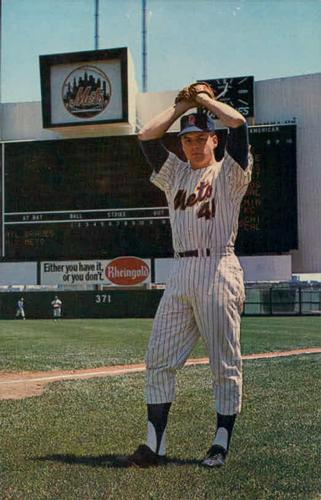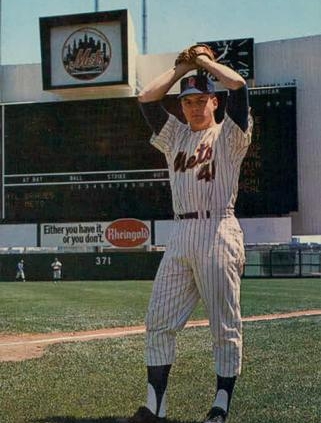April 25, 1967: Tom Seaver pitches first complete game, scores winning run in 10th
 In 1966 the New York Mets lost fewer than 100 games and finished out of the National League basement for the first time in franchise history.
In 1966 the New York Mets lost fewer than 100 games and finished out of the National League basement for the first time in franchise history.
But the Mets still needed to strengthen their starting rotation if they wanted further improvement on their 66-95 record and ninth-place finish. No major-league team in 1966 had used as many starting pitchers as the Mets’ 16. Their top three starters, Jack Fisher, Dennis Ribant, and Bob Shaw, each won only 11 games, and their 33-win total was the second-lowest for a “top three” in the major leagues.1 Only one other team’s top starter, the Chicago Cubs’ Ken Holtzman, won fewer than 12 games.
Luckily for the Mets, help was on the way. In April 1966 they signed Tom Seaver, who spent the season in Triple A with Jacksonville, posting a 3.13 ERA and 188 strikeouts. The 22-year-old right-hander was on the major-league roster for Opening Day 1967.
The Mets began the season with a dramatically changed roster. Only nine players who had started the 1966 season with the Mets were still with the team.2 Besides Seaver, the newcomers included fellow rookie pitcher Jerry Koosman and veteran outfielder Tommy Davis, a two-time batting champion and Brooklyn native acquired from the Los Angeles Dodgers in a November 1966 trade. Another offseason deal brought right-hander Don Cardwell from the Pittsburgh Pirates to fortify the Mets’ rotation.
New York Times columnist Arthur Daley had one of the dimmest views of the Mets’ 1967 prospects in his preseason preview of how the NL teams would finish. “The Shea Stadium tenants were apparently so overcome by the relatively rarified [sic] atmosphere of ninth place [in 1966] that they were gasping for breath and survival when last seen in Florida [during spring training]. This looked to be a team in such distress in so many positions that it is mired in quicksand.”3
The Mets made it through their first 11 games with a 4-7 record, but Seaver was an early bright spot. He made his debut on April 13 against the Pirates, in the Mets’ second game of the season. He left with one out in the sixth and the score tied after allowing two runs and striking out eight, and received a no-decision when the Mets scored the winning run in the bottom of the eighth.
Seaver’s second start was on April 20, at home against the Cubs, and he notched his first major-league win. This time, he pitched until one out in the eighth, giving up only one run, striking out five, and walking none.
The Mets traveled Wrigley Field for their 12th game on April 25, following three straight losses at home to the Philadelphia Phillies. It was Seaver’s third big-league start.
The day in Chicago was more like winter than spring. Seaver wore two sweatshirts to ward off the game-time temperature of 40 degrees. Opposing him before just 1,017 at Wrigley Field4 was left-hander Holtzman, at 21 a year younger than Seaver but already in his third major-league season.
Like Seaver, Holtzman played just one season in the minors (in 1965) before being called up to the Cubs. Chicago had selected him in baseball’s first-ever amateur draft in June 1965, and he played just 12 games in two leagues in the low minors before making his major-league debut on September 4, 1965. A regular in the Cubs’ rotation in 1966, Holtzman won a club-high 11 games and outdueled Los Angeles Dodgers stars Don Drysdale and Sandy Koufax for two of his wins.
Topping the Cubs’ lineup against the Mets were two future Hall of Famers, left fielder Billy Williams, batting third, and third baseman Ron Santo, batting cleanup. The previous season Santo had led the National League in walks (95) and on-base percentage (.412). (A third Cooperstown-bound Cub, Ernie Banks, was not in manager Leo Durocher’s lineup against Seaver.)
It was a pitchers’ duel between Seaver and Holtzman from the start. Through five innings, only two Cubs even reached scoring position off Seaver. Ken Boyer’s error on Don Kessinger’s grounder to third, followed by a sacrifice, gave the Cubs a runner on second in the first, but Seaver retired Williams and Santo to strand Kessinger.
The Cubs stirred in the fourth with Glenn Beckert’s bloop single behind second and Williams’s high chopper that Seaver fielded but had no play on. Again, Seaver was up to the challenge, fanning Santo and getting Lee Thomas to hit into a double play.
If anything, Holtzman was even more effective in the first five innings, fanning seven Mets to Seaver’s three Cubs. The only New York runner in scoring position during that time was Seaver himself, who walked with two outs in the fifth and advanced to third on Cleon Jones’s single. Tommie Reynolds had a chance to break the scoreless tie but fouled out.
Holtzman set down the first two Mets in the sixth, and Ron Swoboda5 hit a sharp bouncer to Santo at third. Santo’s hurried throw got past first baseman Clarence Jones, who was playing in his second major-league game; Swoboda was safe at second on the single and the error by Santo. Jerry Grote’s single drove in Swoboda for a 1-0 Mets lead.
Seaver made his slight advantage stand up over the next three innings. The only baserunner he allowed from the sixth inning through the eighth was on Thomas’s one-out single in the seventh, but Clarence Jones hit into a double play to end the threat.
The score was still 1-0 when Seaver opened the bottom of the ninth by walking Kessinger on a full-count pitch, the only walk for a Cub batter all game. Kessinger took second on Beckert’s sacrifice but held there as Seaver fielded Williams’s grounder and threw to first for the second out.
Santo was the last hope for the Cubs. Seaver got ahead of him with two strikes, then Santo fouled off the next two pitches.
Then, as Newsday reported, Santo swung “over Seaver’s two-strike fastball” and hit a four-bouncer “a few steps to [Bud] Harrelson’s right.”6
Harrelson reached for the prospective game-ending out, but “rose to throw too quickly and the ball skittered under his glove”7 for an error. “Harrelson, undoubtedly concerned with Kessinger, failed to come up with the ball, which dribbled far enough onto the outfield grass for Don to score the deadlocking run,” observed the Chicago Tribune.8
Harrelson, Seaver’s Triple-A teammate a season earlier, was the Mets’ 22-year-old Opening Day starter at shortstop in 1967, after making late-season appearances in the majors in 1965 and 1966, because of the career-ending injury Roy McMillan suffered in Pittsburgh the previous August.9
Seaver retired Thomas on a fly ball, sending the game to extra innings.
In the dugout, Harrelson “flung his glove against the bench.”
One pitch from a shutout win for Seaver and the Mets, and the game was now tied.
“It felt like all the air went out of the balloon,” Seaver said afterward.10
New York’s pitcher’s spot was due to lead off the 10th, and Mets manager Wes Westrum let Seaver bat against Bill Hands, who had replaced Holtzman after the eighth.
Seaver came through with a sharp single to right for his second major-league hit. A sacrifice and a wild pitch put him on third with two outs. Durocher ordered a walk to Boyer and brought in left-hander Bob Hendley to face lefty-swinging Al Luplow.
Luplow took a curveball for a strike, then lined a fastball to right-center for a single. Seaver scored, and the Mets led, 2-1.
Seaver sealed his four-hitter, his second big-league win, and his first complete game when he prevented the Cubs’ sixth, seventh, and eighth batters in the order from reaching base in the 10th.
“In the 10th, something happened,” Seaver said. “I got that adrenalin. I didn’t get it in the ninth. I just thought, ‘That SOB is not going to hit that unprintable ball.’ I just concentrated on throwing the wool-wound rubber core out of the ball.”11
Harrelson squeezed Adolfo Phillips’s popup near second for the final out.
“How could I be upset at Bud?” Seaver said afterward. “Bud made some helluva plays at Jacksonville last year for me. I can name three games he saved for me in the field.”12
Seaver may not have been unhappy with Harrelson’s performance, but Westrum likely was. In the Mets’ doubleheader on April 30, Westrum benched Harrelson both games – “Sandy Alomar, the shortstop replacement for glove-slumping Bud Harrelson,” noted the New York Daily News.13
The Mets did not continue 1966’s progress in the NL standings, finishing 1967 with a 61-101 record and in 10th place – and without Westrum, who resigned on September 21. But Seaver built on his early promise, setting team records in wins (16), complete games (18), strikeouts (170), and ERA (2.76), while recording the final three outs in the NL’s All-Star Game win and receiving NL Rookie of the Year honors.
Reporting on the first of Seaver’s 231 career complete games over 20 seasons, one of New York’s veteran sportswriters had visions of a brighter future in Flushing.
“Tom Seaver, the kid picked out of a hat by Commissioner Spike] Eckert, thus making the commissioner the best scout the Mets have, today continued his rookie magic by beating the Cubs, 2-1, in 10,” wrote Dick Young in the New York Daily News. “Seaver not only limited the Cubs to four singles and no earned runs, but singled to open the 10th and scored the winning run, making him something of a well-rounded Frank Merriwell.”14
Acknowledgments
This article was fact-checked by Bruce Slutsky and copy-edited by Len Levin.
Sources
In addition to the sources cited in the Notes, the author consulted Baseball-Reference.com, Statcast.com, and Retrosheet.org for player, team, and season data. He also consulted game coverage in the Chicago Tribune, Newsday, and New York Daily News newspapers.
https://www.baseball-reference.com/boxes/CHN/CHN196704250.shtml
https://www.retrosheet.org/boxesetc/1967/B04250CHN1967.htm
Photo credit: Tom Seaver, Trading Card Database.
Notes
1 The Chicago Cubs ranked last, with their top three starters in wins winning just 27 games. By contrast, the NL champion Los Angeles Dodgers’ top three starters won 58 games.
2 Joseph Durso, “Mets Start North with Only 9 Men from 1966 Opening-Day Roster,” New York Times, April 8, 1967: 50.
3 Arthur Daley, “Out on a Limb,” New York Times, April 9, 1967: 192.
4 That was the lowest attendance at any Mets game in 1967. It was also the smallest crowd to see the Cubs that season.
5 In 1967 Swoboda played first base 20 times, including the first 10 games in which he played that season. It was the only season in his Mets career in which he played that position.
6 Steve Jacobsen, “Mets Survive Visit by Ghost of Yesterday,” Newsday (Long Island, New York), April 26, 1967: 90.
7 “Mets Survive Visit by Ghost of Yesterday.”
8 Edward Prell, “Seaver Uses Bat and Arm to Win, 2 to 1,” Chicago Tribune, April 26, 1967: 60.
9 Dick Young, “McMillan Tries, but Injury Wins,” Jefferson City (Missouri) Daily Capital News, May 5, 1967: 12.
10 Jacobsen, “Mets Survive Visit by Ghost of Yesterday.”
11 “Mets Survive Visit by Ghost of Yesterday.”
12 “Mets Survive Visit by Ghost of Yesterday.”
13 Dick Young, “Mets Fly, 2-0; Flameout, 3-2,” New York Daily News, May 1, 1967: 56.
14 Frank Merriwell was a fictional multisport star, featured in dime novels, comic strips, and radio from the 1890s through the 1930s. Dick Young, “Seaver 4-Hits Cubs, 2-1,” New York Daily News, April 26, 1967: 71.
Additional Stats
New York Mets 2
Chicago Cubs 1
10 innings
Wrigley Field
Chicago, IL
Box Score + PBP:
Corrections? Additions?
If you can help us improve this game story, contact us.


